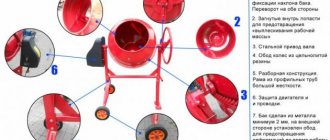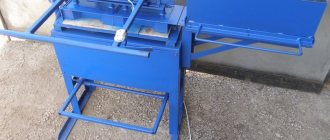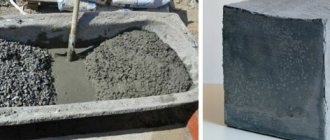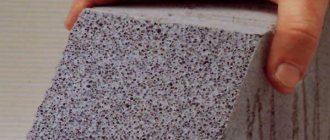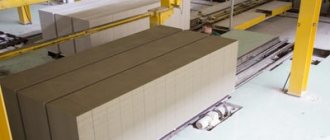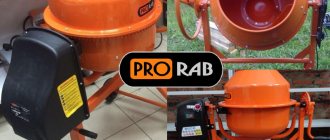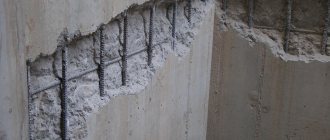Concrete is one of the most common building materials. Its mechanical characteristics after hardening largely depend on the quality of mixing. To mix the working solution on construction sites and in everyday life, concrete mixers are used, which are also called concrete mixers. The use of this special equipment, compared to manual mixing of the prepared mixture with a shovel, can significantly increase productivity, as well as improve the quality of poured concrete. The market is filled with models of various types, having different technical and operational characteristics. This article will help you choose the best technology option for both home and professional use.
How to choose an electric concrete mixer
Before buying a concrete mixer with an electric motor, read the reviews and pay attention to characteristics such as:
1. Volume of the drum and volume of the finished mixture
The volume of the drum and the volume of the finished mixture are indicated in the technical characteristics of the tool. The second digit is usually 2/3 of the first. You cannot exceed it, otherwise you will overload the engine and worsen the batch.
- A 100-liter concrete mixer will be enough to build a bathhouse, garage, gazebo and carry out repairs.
- 100–150 liters - if you are planning to build a one-story house.
- A 150–300 liter concrete mixer is suitable for the construction of houses up to 3 floors in height.
- Larger volumes of the mixture are used in the construction of warehouses, as well as in the construction of high-rise structures by professional builders.
2. Mixture unloading mechanism
When working with a manual drive, typical for devices with a volume of up to 300 liters, special steering wheels and handles are used. Larger concrete mixers have buckets, or skips, whose movements can be adjusted.
To unload the mixture, simply tilt the drum by turning the handle or wheel. The mixture will drain from the walls.
3. Power
Average power is about 700 W. with a volume of 170 l - suitable for work lasting up to 12 hours. For long-term operation, devices with a power of 1,000 W or more are suitable.
4. Drive type
A crown drive involves the presence of a steel, plastic, synthetic or cast iron crown that encircles the drum and receives the rotational action of the engine. This is how the tank is set in motion. When worn, the crown can be easily replaced without requiring significant costs. This explains the popularity of crown concrete mixers.
The gear drive is protected from construction debris. The unit reduces the output shaft rotation speed, increasing torque. The gearbox will last longer than the crown, but when it fails, the drive mechanism will have to be completely replaced, which will not be cheap.
5. Number of revolutions per minute
The homogeneity of the mixture and the mixing speed depend on this parameter. Optimal - from 24 rpm. For a “soft” mixture with a high water content, 18 rpm is permissible, for a “hard” mixture with a low water content - from 25 rpm.
6. Details
- The frame on which the concrete container is installed must be strong.
- The larger the wheels, the easier it will be to move the concrete mixer.
- It is desirable that the blades inside the tank are curved rather than straight. This way you will get a homogeneous mixture in less time.
- The gearbox guard will provide the greatest strength if it is made of metal rather than plastic.
Concrete mixers: price
The cost of a concrete mixer directly depends on its main characteristics, in particular on the volume of the prepared solution. Small devices with a capacity of 100 to 200 liters can be purchased, on average, for 150-250 USD. Concrete mixers designed for 200-350 liters of solution are more expensive - from 300 to 1000 USD. Well, large mobile construction mixers can cost from 4000 USD. and higher.
To ensure that money is not wasted, before purchasing such a device it is necessary to correctly assess the scale of construction, since an overly large concrete mixer, as well as a too small device, will not so much help as hinder the work of builders. In addition, it makes sense to find out about the manufacturers of this equipment, since prices at factories that manufacture similar products are much lower than in stores. You can also use the services of online stores that work directly with concrete mixer manufacturers. In this case, the markup will be minimal and will be fully recouped due to free delivery.
How to choose a concrete mixer crown?
The crown represents a closed ring with many teeth. This element is needed to set the drum in motion. It is connected to the drive gear, to which rotation is transmitted from the electric motor. Most often, the crown wears out after prolonged use, accidental impacts, exposure to excess dust and rain, or work in extremely low or high temperatures.
To extend the service life of the equipment, it is enough not to touch or drop the concrete mixer, lubricate the place of contact with the drive gear and regularly clean the crown with a brush and water.
- The cast iron crown is suitable for occasional use without heavy loads. It is easy to produce, inexpensive and very popular, but has one drawback: fragility. The cast iron crown is not resistant to mechanical damage and vibration loads. Makes a lot of noise.
- The steel crown is stronger and more expensive. Suitable for continuous and heavy work, ideal for interior decoration. Another advantage of such a crown is its silent operation.
- Plastic crowns are ideal for the construction of small private buildings. Among the advantages are low cost, lack of noise during operation, and low weight. Such devices are less susceptible to vibrations than cast iron ones.
- Crowns made of polyamide are not subject to corrosion and are resistant to high and low temperatures. Such products are durable and are not affected by dust or abrasive particles. They consist of several parts, which can be replaced instantly, without disassembling the drum. They last almost 2 times longer than steel ones and do not make noise. Versatile.
What to look for when choosing a forced concrete mixer
| Volume of container for mixing ingredients | Concrete mixers differ from each other in drum size. When choosing a unit, it is important to consider its purpose. For example, to build a gazebo or garage, a concrete mixer with a volume of up to 100 liters will be sufficient. For the construction of a private house - a 100-300 liter unit, for large construction - a capacious industrial concrete mixer. |
| Power | The larger the drum, the more powerful the engine must be. If the concrete mixer is used continuously, day and night, then choose models with a motor of 1000 W or more. For non-intensive use, models with low-power engines are suitable. |
| Construction quality | Look for models with a durable, thick metal drum and metal blades. Such concrete mixers can withstand heavy loads and have a long service life. |
A high-quality concrete mixer is a guarantee that the concrete will meet all requirements and existing standards, and the object being built will last a long time without problems. You can buy reliable models of concrete mixers and other equipment for concrete plants at affordable prices.
Gravity and forced type concrete mixers: which one to choose?
In concrete mixers with a gravity mechanism, the mixture rotates along with the drum, falling under the influence of gravity (hence the name of such concrete mixers). The solution is well mixed thanks to the blades attached to the walls of the drum. So, the mixture does not stick to the walls. Gravity-type devices allow you to mix dry and semi-dry components and create a cement-sand mixture with or without crushed stone.
- Pros: ease of transportation due to low weight; low cost; low power consumption.
- Cons: obtaining a homogeneous mixture requires a lot of time; Suitable only for coarse mixtures, since only a small power is required to grind them.
In forced-type auger concrete mixers, the drum does not move when mixing the solution. The blades located on the shaft do all the work themselves. Such models are universal, suitable for creating consumables, cinder blocks, paving slabs, foundation blocks, etc. As a result, you will receive a homogeneous solution in little time: to prepare 0.45 cubic meters. m. with an engine power of 1,000 W, 5 minutes will be enough.
- Pros: high performance; excellent quality of the solution (any mixture turns out homogeneous).
- Cons: high power consumption; heavy weight.
Purpose and principle of operation
A concrete mixer is used for preparing concrete, cement, mortar and feed mixtures from solid or granular components. The main function of the unit is to improve the quality of the resulting solution compared to mixing with hand tools. The operation of the concrete mixer is carried out due to the operation of a gasoline or electric motor, a rotating container and blades that cut the concrete mass.
Devices for mixing the solution come in different types: for private use, small-capacity mini-units are used, and on an industrial scale, large mobile units are used. The size of a concrete mixer depends on the specific task: capital construction (construction of swimming pools, foundations, access roads) requires a large-sized mixer for the production of large volumes of solutions. To solve small construction tasks, compact units are used. Typically, during large-scale construction, both types of concrete mixers are used.
The design of the concrete mixer consists of the following parts:
- A working container in the form of a drum with blades for mixing components.
- Base (frame).
- Electric motor with gearbox.
The volume of the container can range from 100 to 300 or more liters, depending on the power of the equipment and the scale of the work performed.
How to assemble a concrete mixer
You can assemble a concrete mixer in several stages:
- Take the rear triangular support and put the wheels on it.
- Secure the wheels with cotter pins and washers.
- Connect the frame to the support either on either side or on the engine side (if it is asymmetrical).
- Attach the second support to the remaining edge of the frame.
- Place the bottom of the drum on the base along with the support attached to it. It is advisable not to do this alone, since the drum and support are very heavy. If you are assembling the concrete mixer alone, separate the support and drum and install them separately.
- Attach the inner blades to the bottom of the drum (in gravity type equipment).
- Place the upper part of the drum in front of you and fix the seal on it or apply sealant to the lower part (depending on what is included in the kit).
- Connect the top and bottom of the drum so that the mounting bolts holding the seal fit into their mounting holes.
- Tighten the mounting bolts with a screwdriver.
- Screw the inner blades to the top half of the drum.
- Attach the tilt angle lock.
- Install the steering wheel, find the “coin” in the fastener and push it into the spring recess.
- Insert the spring.
- Holding the spring, place the steering wheel against the mounting holes.
- Thread the supplied bolt. Screw 2 17mm nuts onto it, without tightening it all the way.
- If the motor is to be located inside the assembled housing, slide it onto the spindle with a pulley and secure with the supplied bolts and special plate.
- If the motor housing is disassembled, attach the lower part of the housing to the concrete mixer frame. Then screw on the pulley. Secure the engine mount without tightening. Attach the motor to it. Put on the belt, then lower the support along with the engine, tensioning the belt. Tighten the engine mount.
- Attach the power wires to the button located on the 2nd part of the case.
- Connect the 2 parts of the body.
Gear and gear units
This type is worth dwelling on separately. Gear and crown concrete mixers are the same thing, there is only a small difference between them, which will be discussed below.
A geared concrete mixer differs from others in that it has a “gearbox” installed on it; a transmission that converts high-speed rotation of the electric motor rotor into low-speed rotation of the drum, with high torque levels. As was said, there is a slight difference between the crown and gear concrete mixers; it lies in the method of organizing such an effect. Thus, concrete mixers of the crown and gear type differ in the method of operation, which depends on the subtleties of each type.
https://www.youtube.com/watch?v=SnAbUMtmpGs
As mentioned earlier, some concrete mixers or concrete mixers have a ring gear attached to them. Such concrete mixers are called crown mixers; for some, they are quite inconvenient, since the crown must be cleaned quite often. This type of concrete mixer is quite easy to operate and repair, and these are its main advantages.
A gear concrete mixer does not have a crown, while the gearbox is closed.
Which direction does the concrete mixer spin?
The drum can rotate in any direction. To achieve the greatest homogeneity of the mixture, change the position of the tank (tilt it) if it is movable, as often as possible. This can be done using the rotary lever or wheel that the model is equipped with.
To unload the mixture, run the drum in the opposite direction. This way the blades can push it out.
Important! Never stop the concrete mixer while preparing the solution. Even while adding components. Otherwise, the concrete mixer will break down much faster.
Types of concrete mixers
Depending on the operating mode, such equipment is divided into:
- Continuous concrete mixers.
They, in turn, can be: -
gravitational
.
In such devices, mixing of the constituent parts of the concrete mixture occurs through the use of the free fall force of these same components. This type of concrete mixer is used in the construction of large objects, since their productivity is about 120-130 m3 of solution per hour. In addition, compared to similar cyclic devices, such concrete mixers have a simpler design and lower metal consumption, and their control, if necessary, can be easily automated - with forced mixing.
The productivity of these concrete mixers is much less - from 5 to 60 m3/h. The main feature of such devices is a twin-shaft paddle mixer (the same as in asphalt concrete plant mixers). - Cyclic concrete mixers.
They are used much more often than similar continuous-action devices.
The name reflects the possibility of dividing the work of the construction mixer into certain cycles: a) loading the components of the mixture; b) mixing; c) unloading of the finished solution. Just like continuous concrete mixers, cyclic devices in this category are divided into: - forced
, in which the mixing process itself is carried out by mechanical parts that interact with the components of the solution.
They can be equipped with a fixed container, horizontal or vertical shafts, and also have a complex design that ensures high quality of the mixture (planetary concrete mixers). – gravitational
, in which the basis of the device’s operation is the free fall of the component parts of the mixture.
How to mix concrete correctly
To prepare concrete, place the equipment on a level surface. If it rains, you will need a canopy: it will prevent drops of water from getting inside.
Then gradually mix water, cement, crushed stone and sand in a ratio of 1:2:4:8 respectively.
First load half of the dry fillers, then half of the water. Add the rest little by little and gradually mix with the existing solution.
Turn on the concrete mixer. The mixing cycle should not exceed 2 minutes, otherwise the solution will lose its quality.
To check if the concrete is ready, tilt the drum and dump out some of the mixture. Use the back of the shovel to make several rows. If they don't lose their shape, unload the rest.
FROM HISTORY: Soviet concrete mixer with a foreign accent
Home > Archive of articles from our newsletter >Issue No. 3. Article No. 1.
Print version >>
| JSC "Mikhnevsky RMZ" OWN PRODUCTION. LEASING SALES SCHEMES | ||
| Bar machines based on MTZ-80/82, DT-75, T-170 Winter and summer chains | Pipelayers and repair and construction machines based on DT-75, T-170, T-150K | MDF and FDN road milling machines based on MTZ-80/82 |
| Drainage installations based on DT-75, MTZ-80/82 | Mobile welding plants based on MTZ-80/82 and DT-75 | Sweeping machines based on MTZ-80/82 |
Nowadays, concrete mixer trucks have integrated so tightly and organically into the construction process that it seems like they have always been there. Now not a single, even more or less significant object can do without this device. However, less than half a century ago, a mixer on wheels was a curiosity in our country.
Actually, the concrete mixer truck owes its birth partly to the advent of the automobile. At the beginning of the last century, the first experiments were made in delivering freshly prepared concrete mixture to construction sites not just in the back of a car, but in a special device that allows this mixture to be delivered in the proper form, namely preserving the required plasticity and homogeneity, which ultimately affects the strength hardened concrete. Moreover, industrial construction methods have given impetus to the creation of mixing vehicles, which are capable of preparing a concrete mixture during transportation from pre-dosed components.
Soviet designers who created the first concrete mixer trucks relied on foreign experience. American machines had a great influence on domestic concrete transport equipment. Already at the beginning of the last century, the United States paid great attention to the issue of transporting concrete mixture without reducing its quality indicators. Initially produced in the United States, a variety of devices for transporting ready-mixed concrete and separately for preparing concrete mix from loaded components on the way, by the mid-30s
years received a unified design.
To achieve this, American firms that manufacture equipment for the mechanization of construction work began to install hermetically sealed horizontal drums on truck chassis, rotating around their axis. Concrete mixture was loaded inside the drum, which was mixed using blades inside the drum. In 1935-1936
. In the USA, they began to produce unified machines, as they were called then, concrete mixer-deliveries, designed not just for transporting the mixture, but also for preparing it on the way.
In 1935, in the USSR, on the initiative of the Soyuzstroymekhanizatsiya trust, technical preparation for the production of concrete mixers and concrete delivery trucks was launched. The Leningrad Institute of Construction Mechanization produced designs for two machines, one of which was specialized for transporting ready-made concrete, and the other for preparing it on the road. In 1936 and 1937 A series of 15 of these machines was manufactured and put into operation. Design flaws and poor workmanship, coupled with the lack of a base for the production of such machines, forced the Soyuzstroymekhanizatsiya trust to stop producing them.
By 1937
In the USA, there has been a clear trend toward unifying both types of purpose in one machine: for transportation and for preparing concrete mixtures. These circumstances prompted the Soyuzstroymekhanizatsiya trust to start producing standardized machines of a more advanced design.
| The first Soviet serial concrete mixer SSSM-738/S-49 on the YAG-6 chassis | Version of concrete mixer based on ZIS-6 |
In 1938
, after two years of preparatory work, the Kiev Glavstroymash began serial production of unified concrete mixer-delivery trucks (hereinafter referred to as concrete mixer trucks)
of the SSSM-738/S-49 model
on the YAG-6 vehicle chassis. The first Soviet serial concrete mixer truck had a mixing drum with a useful capacity of 1.5 m3, a water tank of 240 + 40 liters (for preparing the concrete mixture and washing the drum, respectively), the drum was driven from the power take-off of the base vehicle. Note that of the first two examples of concrete mixer trucks manufactured at the Red Excavator, one was on the YAG-6 chassis, the other on the ZIS-6. The controls for the reverse clutch, transmission reduction clutch and clutch engagement were moved to a separate control station at the drum unloading hole. The activation of the power take-off, as well as the activation of the clutch, could be carried out directly from the cab while on the move, as well as the control of the water tank valve.
Despite all its advantages, primarily the delivery of a homogeneous concrete mixture to the site, the new product was not without its drawbacks. The main flaw was the lack of an individual drive motor for the mixing drum. The power of the 73-horsepower ZIS-5 engine installed on the base YAG-6 vehicle was not enough to ensure proper drum rotation, when connected, the vehicle lost speed and acceleration dynamics. And the mixing was uneven; the rotation speed of the drum directly depended on the degree of opening of the carburetor throttle valve. And locking two clutches with one pedal required remarkable strength from the driver. And this is not a complete list of disadvantages, the number of which clearly outweighed the existing advantages. Compared to its American counterpart, which took part in comparative tests, our concrete mixer showed worse mixing quality over a longer period of time. It also turned out to be heavier, although the initial weight of the superstructure was reduced from 2450 to 1840 kg. Equipment on foreign vehicles of the same capacity weighed 300-500 kg less. When comparing the productivity and efficiency of domestic dump trucks and concrete mixer trucks, the latter were inferior in these parameters
In addition to the concrete mixer truck SSSM-738, produced by , at that time there was another model, manufactured in Leningrad through the joint efforts of the Leningrad Institute of Construction Mechanization and the 16th Stroytrest. The AB-38 concrete mixer truck was based on the chassis of a three-axle ZIS-6 truck. Despite the fact that the ZIS-6 had a lower carrying capacity than the YAG-6, it was equipped with a larger volume mixing drum (full - 4 m3, useful - 2.2 m3). According to reviews from operators, the design of the AB-38 turned out to be better than the SSSM-738. The main disadvantage of this vehicle is the reduced speed of movement, which is due to the overload of the chassis.
The next stage of development
designs of domestic concrete mixer trucks occurred in the post-war period.
| Post-war S-269 on ZIS-150 chassis | The first domestic concrete mixer truck S-224 with an autonomous engine based on the YaAZ-200 |
At the end of the 40s,
VNIIstroydormash developed a project
for a concrete mixer truck S-269
on the chassis of a ZIS-150 truck. A prototype of the machine was manufactured by Moscow. Unlike pre-war designs, the new product had a number of fundamental differences: the mixing drum was not cylindrical, but pear-shaped, and was not installed horizontally, but at an angle of 17° to the horizon. Its useful capacity was slightly higher than that of its predecessor SSSM-738 - 1.6 m3 water tank, also of increased capacity: 270 + 80 liters. The type of drum drive remained unchanged; as before, it was carried out from the power take-off box of the base car, which was a significant drawback. Compared to the SSSM-738, the S-269 concrete mixer truck gained almost half a ton in weight, its superstructure weighed 2308 kg. True, after modification the car became lighter; the weight of the modernized version of the S-306 was 2185 kg.
The same company produced a heavier concrete mixer truck S-224
on the YaAZ-200 chassis. The design of the drum, loading and unloading devices, as well as water communications was similar to the S-269 machine. The useful capacity of the mixing drum for the output of the finished mixture when loading with dry materials was 2 m3, and for loading with the ready-made concrete mixture - 2.4 m3. The angle of inclination of the drum to the horizon was somewhat more important - 20 °. The fundamental difference from the S-269 was the individual drum drive from the GAZ-MK engine with a power of 30 hp. The inconvenience was that the base car had a diesel engine, while the drive car had a gasoline engine.
Unfortunately, history has not conveyed to us information about how large the production of concrete mixer trucks based on the ZIS-150 and YaAZ-200 vehicles was, and whether they were mass-produced at all. Only in the late 60s did the domestic industry master the mass production of concrete mixer trucks.
In the second half of the 60s
VNIIStroydormash developed projects for two
concrete mixer trucks - S-942 (SB-58) on the KrAZ-258 chassis and S-1036 (SB-69) on the MAZ-505B chassis
, the production of which was launched in 1968-1969. Slavic plant of construction machines.
| S-942 - the third generation of Soviet concrete mixer trucks | An early version of the S-1036 on the MAZ-503B chassis (left) and a later version of the S-1036B on the MAZ-5549 chassis | |
The new machines generally retained the layout solutions adopted on domestic models developed in the late 40s, which corresponded to established global trends.
However, there was a significant difference in the kinematics - on all previous machines the gear ring of the drum received rotation directly from the gear of the gearbox output shaft, on the new products the transmission was chain. The mixing drum of both machines was driven by a D-37MSZ diesel engine with a power of 40 hp. According to the carrying capacity of the base chassis, the useful capacity of the S-942 mixing drum was 3.2 m3, S-1036 - 2-2.5 m3. The S-1036 concrete mixer truck, unlike the S-942, had greater capabilities due to the design of the mixing drum: it could prepare not only mobile concrete mixtures, but also hard ones. Soviet designers did not stop there. Already in the early 70s
VNIIStroydormash has developed improved
concrete mixers SB-92
with a capacity of 4 m3 based on KrAZ and SB-83 with a capacity of 4.5-5 m3 - on a semi-trailer for the MAZ-504 vehicle.
| SB-92 was characterized by an increased speed of unloading the concrete mixture | SB-92V-1 - modification based on KamAZ |
In 1972, the SB-92 was accepted for production by the Slavyansk Construction Machinery Plant.
It was distinguished from the S-942 by the larger capacity of the mixing drum, the more powerful 50-horsepower D-37S-1 drive motor, and the design of the drum. To increase the rate of unloading of the concrete mixture, the angle of inclination of the drum axis to the horizon was reduced from 18° to 15°. The internal tail of the drum received flat profile helical blades located perpendicular to the conical surfaces of the drum. With the development of the KamAZ-5511 car by the automotive industry in the second half of the 70s, the Slavyansky Plant began production on its basis of a modification of the SB-92-1 concrete mixer with a capacity of 4 m3. In the mid 70s
The annual production volume of concrete mixer trucks in the USSR was several hundred; for example, 253 machines were produced in 1973, and 340 in 1974. However, the construction industry required a much larger quantity. At that time, the only manufacturer of such equipment in the Soviet Union was the Slavyansk Construction Machinery Plant, whose capacity was clearly insufficient. Therefore, in 1973, the Soviet government decided to build a new concrete truck plant in the city of Tuymazy, Bashkir Autonomous Soviet Socialist Republic. Construction began in the spring of 1976. At the same time, the Tuymazinsky Experimental Construction Machinery Plant was built, where on November 5, 1977, the first prototype of the SB-113 concrete truck was produced. On January 28, 1980, the Ministry of Construction and Construction Engineering issued an order to merge the two factories. This date is considered the official starting point of the history of the Tuymazinsky concrete truck plant. In the first year of operation alone, the factory workers produced 81 SB-92 concrete mixer trucks, 15 SB-126 concrete pump trucks and 166 SB-89 mortar trucks. The equipment produced by the Tuymazinsky plant was supplied to both domestic and foreign consumers: Bulgaria, Cuba, Angola, Vietnam, Syria, Hungary, China, India.
| The fruit of joint cooperation and the Kamensk Experimental Mechanical Plant | The SB-159 used a hydraulic drum drive (the picture shows the SB-159V modification) |
The rapid development of the production of concrete mixer trucks in the Soviet Union occurred in the 80s
, thanks to the commissioning of the Tuymazinsky concrete truck plant and the start of licensed production of German equipment at the Kamensky Experimental Mechanical Plant in 1979 and at the Pushkin Mechanical Repair Plant in 1980. True, the bulk of the equipment produced by the Kamensky and Pushkin plants was sent abroad. In Germany, Soviet enterprises supplied metal structures for mixing plants, and complete concrete mixer trucks were produced in relatively small quantities for the local market. For example, the Kamensky plant at that time produced about 1000 sets of installations for the foreign market and 200 machines for the needs of Soviet builders.
Meanwhile, Soviet designers continued to create their own designs. In 1980-1981 The Slavic Construction Machinery Plant, according to the VNIIstroydormash project, created the SB-130 concrete mixer truck and the SB-132 concrete mixer truck, unified with it, on a semi-trailer chassis working in tandem with a KamAZ-5410 tractor. The drum had an impressive volume of 8 m3 and was driven by its own D-145T diesel engine. But the main difference from all previous machines was the use of a hydraulic drum drive instead of a heavy and complex mechanical transmission. The new drive scheme was used in further domestic developments - the 6-cc concrete mixer truck SB-127 on the KrAZ-6505 chassis (1982), the 5-cc concrete mixer SB-159
on the KamAZ-5511 chassis (1983), as well as on later vehicles.
Based on materials from the specialized magazine “Construction Equipment and Technologies”.
With the permission of the editors, materials from the article “Soviet concrete mixer truck with a foreign accent” were used, V. Novoselov, No. 2(36)2005
How to pour a foundation with a concrete mixer
Do the preparatory work:
- Assess how deep the groundwater is.
- Calculate the level of soil freezing.
- Study the composition of the soil and its properties.
- Measure the pressure level of the building on the foundation.
- Mark the area where construction is taking place. Use wooden pegs and ropes.
- Remove the top layer of soil (up to 15 cm).
- Build a trench.
- Install a drainage pad made of a mixture of crushed stone and sand.
- Build formwork from wooden panels.
- Install the reinforcement mesh.
Now you can pour the foundation. This can be done in 2 layers, or oriented towards the formwork panel. By layers - faster and easier. Let's consider this method.
First you need to compact each layer with a vibrating plate or tamper.
After pouring, cover the concrete with polyethylene film. Moisturize every 3-4 hours. After a week - every 7 hours.
When using a concrete mixer when pouring the foundation, keep in mind that:
Concrete mixer and its properties
The choice, both for purchase and for rent, is indescribably great. Thus, for a high-quality selection of a unit, you need to consider several types, focusing on drum dimensions, load capacity and other technical properties, for a more profitable allocation of funds.
A concrete mixer is a special construction machine whose main task is to mix materials to produce concrete.
Concrete mixers are classified:
According to the principle of action:
Forced action - a motionless drum, the substance is mixed forcibly, using blades. Gravitational - mixing of matter occurs under the influence of natural forces, namely, the force of attraction. Continuous action. Repeated act.
Scheme of a forced concrete mixer.
Depending on the size and type of substance:
Concrete mixers. Mortar mixer or mortar mixer.
According to the ability or impossibility of movement:
Mobile. Stationary, with a huge amount of productivity.
What each of the subspecies is, what its individualities are and how to work with them is described below.
How to clean a concrete mixer
You can clean the concrete mixer with chemicals (Barracuda, Himfrez, Lugato, Divinol Mischerschutz, cement solvent Bio Decap Beton Guard), or mechanically. We'll tell you more about it. So, you can clean the concrete mixer:
- Rubble. Pour 3 liters of water and add 2 buckets of crushed stone, turn on the concrete mixer and wait 15 minutes. Make sure the mixture gets to the inner edges.
- A grinder with a brush as an attachment.
- Sandpaper. It is suitable if there are small particles left on the walls of the drum.
- High pressure washer. A mini-wash will help you clean your concrete mixer as quickly as possible, without the risk of injury or damage to the equipment. A powerful stream of water allows you to wash both fresh and hardened solutions.
It is not recommended to use a hammer, shovel or chisel. They will scratch your equipment.
| Whirlwind BM-180 | Allows you to prepare a 130-liter solution in 3–7 minutes. Equipped with a 0.8 kW electric motor and a cast iron crown with a coating that protects against corrosion. Supplemented with an inclined steering wheel, making it easier to tip over the mixture. Wheels make it easy to move the concrete mixer. |
| Zitrek Z140 | Reliable equipment with a 0.55 kW motor. Operates from a 220 V network. Allows you to prepare up to 75 liters of mixture. The model is equipped with wheels, a reinforced frame and a protective system that prevents overvoltage and overheating. |
| Patriot 162C | Gravity electric concrete mixer, allowing you to load up to 160 liters of mixture. Operates on 220 V. The crown is cast iron. The model is protected from corrosion. Compact. Has wheels for easy transportation. |
| Tsunami RM 120L | One of the best domestic gravity concrete mixers with an electric motor. The model is protected by a casing that prevents moisture and dust from entering the construction site. Weighs only 43 kg. |
| Helmut BM160 | A powerful unit from a German manufacturer allows you to get 110 liters of ready-made solution in 1 batch. The pedal drive that the model is equipped with simplifies tipping. The drum is made of steel, the crown is made of durable cast iron. Motor power - 0.65 kW. |
| Stroymash SBR-800 | Concrete mixer with a power of 7.5 kW, which allows you to get 750 liters of concrete solution in 1 start. Works silently and smoothly. The crown is made of durable cast iron. The hydraulic drive of the skip allows you to lift all the components of the mixture for loading into the concrete mixer. Stability is ensured by a wide base. Convenient wheels ensure ease of transportation. Operates from a 380 V network. Suitable for professional construction purposes and continuous operation. | |
| Zitrek RN SB-300 Skat | Powerful 7.5 kW model with steel crown and body. Protected from corrosion and resistant to mechanical damage. Allows you to load 220 liters of mixture components at each start and achieve maximum solution homogeneity. Component fraction: up to 40 mm. The working clearance of the blades is adjustable. Forced type mechanism (with a fixed drum). | |
| Imer Syntesi 350 R Robin | The right choice for heavy loads. The body is made of steel. Equipped with a 4 kW petrol engine. Allows you to load 280 liters of mixture components and get 180 liters of concrete with each start. This model has a gravitational type of mechanism. The lockable handwheel ensures easy tilting for convenient unloading. There is a high-quality vehicle mount and large wheels for easy transportation. |
Author of the article: Sergey Zuikov
Mortar mixers and their classification
Scheme of a mortar mixer.
The mortar mixer is a simple unit that is easy to use and can be used in private construction.
The main difference between a mortar mixer and a concrete mixer is the material with which these devices work. Concrete mixers work with materials that contain fractions of solid filler measuring 20-70 mm. The mortar mixer is designed to work with fillers with smaller fractions. The volume of the mortar mixer drum varies, its volume varies from 30 to 1200 liters.
Mortar mixers, like concrete mixers, come in two types:
- Forced mixing.
- Gravitational.
In mortar mixers, the components are most often mixed forcibly; a rotating horizontal shaft is used for this with a stationary drum. Small-volume mortar mixers do not have dispensers; they are installed on mortar mixers with a volume of 100 liters or more. Thus, it is necessary to measure the amount of water added to the solution “by eye”.
If we take for consideration a mortar mixer of medium volume, 250 liters, then we can distinguish the following components:
- Electric motor or internal combustion engine.
- Drive unit.
- Blade shaft.
- Trough-shaped mixing drum.
Scheme of a gravity mortar mixer.
From mortar mixers with a volume of 30 to 65 liters, the solution is removed by tilting the drum. If the drum has a large displacement, then most often such devices have a hatch for dumping the mixture.
Just like concrete mixers, mortar mixers come in industrial and private sizes. Materials are discharged into industrial-scale mortar mixers using a specialized mechanized device.
Concrete mixer: a machine that facilitates the construction process
A concrete mixer, or concrete mixer, is a special machine for construction work, which is designed for mixing concrete and other solutions used for pouring the foundation, making screeds or brickwork. The device will also be a good help in the process of gluing tiles and when performing other types of construction work.
A concrete mixer is a device for mixing concrete and other solutions.
Externally, a concrete mixer is an open container into the middle of which the components of concrete are poured, that is, cement, sand and water. A component such as gravel may also be present. The machine prepares the solution by stirring. Then it is poured into a separate container using a special mechanism.
The device greatly facilitates, optimizes and speeds up the work process on the construction site. Of course, you can order the solution or prepare it in a trough, stirring with a shovel, but it’s much easier to pour in the ingredients and just press the button. At the same time, not everyone knows which concrete mixer to choose. As a result, during the construction of a small house you can find bulky equipment running idle, or small concrete mixers on huge sites.
There is a wide range of such products on the modern market. At the same time, the models are distinguished by their long service life, ergonomic devices and ease of use. Having decided on the required volume, power and other parameters, you can easily choose the best option.
First of all, you should familiarize yourself with the variety of types of concrete mixers. Devices are classified according to the following criteria:
- according to the operating principle;
- drive type;
- tank capacity;
- power;
- type of food.
Concrete mixers are classified according to their operating principle, drive type and tank capacity.
On a note! The gravity concrete mixer is equipped with special emptying mechanisms, which allows you to simply and quickly remove the solution. In addition, the price of such mixers is significantly lower than the cost of forced-type machines, which mix the solution with fine components more efficiently.
BELAMOS VX180
Main characteristics:
- Drive type - crown;
- The crown material is cast iron;
- Power, W - 650;
- Drum volume, l - 180;
- Volume of the finished solution, l - 90;
- Weight, kg - 74;
- Dimensions, mm -1260x850x1400.
Frame, wheels. This concrete mixer from a well-known domestic brand weighs just over 70 kg. It has a prefabricated frame made of metal profile with one fixed support and a pair of wheels for easy transportation. When assembled, it occupies a space of 126x85x140 cm.
Drum, crown, blades. The gravity-type cylindrical steel drum with a cone-shaped neck has a volume of 180 liters. It has two blades attached from the inside to the side walls. In it, you can prepare a batch of concrete solution up to 90 liters at a time. The tipping device is made in the form of a large steering wheel with the ability to be fixed in any convenient position.
The loading opening with a diameter of 400 mm simplifies filling of the mixture and cleaning of internal surfaces. The cast iron ring gear is abrasion resistant and designed to last a long time.
Power point. The unit is driven by a 650 W electric motor that rotates the drum at a speed of 29 rpm. It is protected from precipitation by a sealed plastic casing. The device is equipped with an internal overload lock.
Pros of BELAMOS VX180
- Prefabricated structure.
- Mobility.
- Reliable materials.
- Detailed instructions for assembly and operation.
- Motor overload protection.
- Acceptable price.
Cons of BELAMOS VX180
- The standard cable with plug is only 1 meter long.
- Insufficient power for the specified maximum volume.
